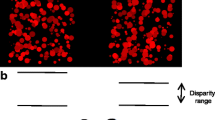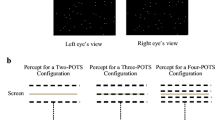Abstract
Similar content being viewed by others
References
Ogle, K. N. (1962) in The Eye, Vol. 4. Visual Optics and the Optical Space Sense (ed. Davson, H.) 271–324 (Academic, New York, 1962).
Bishop, P. O. in The Neurosciences: Second Study Program (ed. Schmitt, F. O.) 471–485 (Rockefeller Univ. Press, New York, 1970).
Julesz, B. Foundations of Cyclopean Perception (Chicago Univ. Press, 1971).
Howard, I. P. Human Visual Orientation (Wiley, New York, 1982).
Howard, I. P. & Rogers, B. J. Binocular Vision and Stereopsis (Oxford Univ. Press, New York, 1995).
Farell, B. Nature 395, 689–693 (1998).
Blakemore, C. & Hague, B. J. Physiol. 225, 437–455 (1972).
McKee, S. P., Bravo, M. J., Taylor, D. G. & Legge, G.E. Vision Res. 34, 1047–1060 (1994).
Author information
Authors and Affiliations
Rights and permissions
About this article
Cite this article
Farell, B. reply: Putting plaids in perspective. Nature 401, 342–343 (1999). https://doi.org/10.1038/43822
Issue Date:
DOI: https://doi.org/10.1038/43822
- Springer Nature Limited





